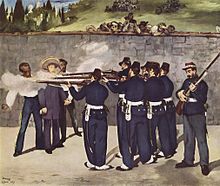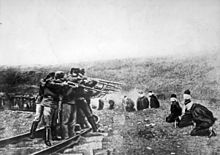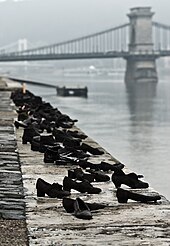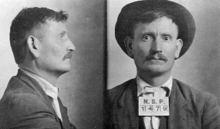Execution by firing squad


Execution by firing squad, sometimes called fusillading (from the French fusil, rifle), is a method of capital punishment, particularly common in the military and in times of war. Execution by shooting is a fairly old practice. Some reasons for its use are that firearms are usually readily available and a gunshot to a vital organ usually kills the subject relatively quickly. Before the introduction of firearms, bows or crossbows were often used — Saint Sebastian is usually depicted as executed by a squad of Roman auxiliary archers in around 288 AD; King Edmund the Martyr of East Anglia, by some accounts, was tied to a tree and shot dead by Viking archers on 20 November 869 or 870 AD.
A firing squad is normally composed of several soldiers or law enforcement officers. Usually, all members of the group are instructed to fire simultaneously, thus preventing both disruption of the process by a single member and identification of the member who fired the lethal shot. The prisoner is typically blindfolded or hooded, as well as restrained, although in some cases prisoners have asked to be allowed to face the firing squad without their eyes covered. Executions can be carried out with the condemned either standing or sitting. There is a tradition in some jurisdictions that such executions are carried out at first light, or at sunrise, which is usually up to half an hour later. This gave rise to the phrase "shot at dawn".
Execution by firing squad is distinct from other forms of execution by firearms, such as an execution by a single firearm to the back of the head or neck. However, the single shot (coup de grâce) is sometimes incorporated in a firing squad execution, particularly if the initial volley turns out not to be immediately fatal.
Military significance
The method is often the supreme punishment or disciplinary means employed by military courts-martial for crimes such as cowardice, treason, desertion, or mutiny. For military servicemen, the firing squad has a symbolic significance. The condemned soldier is executed by a group of his peers, indicating that he is found guilty by the entire group. Although a court-martial might be presided by and prosecuted by officers, the instruments of execution are the ordinary weapons fired by members of the group from which he is being expunged. Furthermore, in judicially approved executions, the condemned man is allowed to stand, rather than kneel; in many cultures, the ability or the will to stand in the face of adversity or danger is considered a salient feature of individual pride. Finally, the group action on one side (being the firing squad), with the condemned standing opposite, presents a visual contrast that reinforces to all witnesses that solidarity is an overriding necessity in a military unit.
Firing squads have been replaced by lethal injection as the only approved method for the judicial execution of U.S. military personnel.[1]

Blank cartridge
In some cases one or more members of the firing squad may be issued a weapon containing a blank cartridge instead of one housing a live round.[2] No member of the firing squad is told beforehand if he is using live ammunition. This is believed to reinforce the sense of diffusion of responsibility among the firing squad members, making the execution process more reliable. It also allows each member of the firing squad to believe afterward that he did not personally fire a fatal shot[3]—for this reason, it is sometimes referred to as the "conscience round".
However, it was a different story in the First World War. Private W. A. Quinton of 2nd Battalion, the Bedfordshire Regiment had the unfortunate experience of being a member of a firing squad in October 1915. He recalled how he and eleven colleagues were relieved of any live ammunition and their own rifles, before being issued with replacement weapons. The firing squad was then given a short speech by an officer before they fired a volley at the condemned man. But "I had the satisfaction of knowing that as soon as I fired, the absence of any recoil, [indicated] that I had merely fired a blank cartridge". [4]
In more recent times, such as in the execution of Ronnie Lee Gardner in Utah in the United States in 2010, a rifleman may be given a "dummy" cartridge containing wax instead of a bullet, which provides a more realistic recoil.[5]

By country
Cuba
When Fidel Castro came to power, persons who had fought in support of Batista were often executed via firing squad. Many of these executions were documented and filmed.
Finland
The death penalty was widely used during and after the Finnish Civil War (January-May 1918); some 9,700 Finns and an unknown number of Russian volunteers on the Red side were executed during the war or in its aftermath.[6] Most executions were carried out by firing squads after the sentences were given by illegal or semi-legal courts martial. Only some 250 persons were sentenced to death in courts acting on legal authority.[7]

During World War II some 500 persons were executed, half of them condemned spies. The usual causes for death penalty for Finnish citizens were treason and high treason (and to a lesser extent cowardice and disobedience, applicable for military personnel). Almost all cases of capital punishment were tried by court-martial. Usually the executions were carried out by the regimental military police platoon, or in the case of spies, by the local military police. One Finn, Toivo Koljonen, was executed for a civilian crime (six murders). Most executions occurred in 1941 and during the Soviet Summer Offensive in 1944. The last death sentences were given in 1945 for murder, but later commuted to life imprisonment.[7]
The death penalty was abolished by Finnish law in 1949 for crimes committed during peacetime, and in 1972 for all crimes.[8] Finland is party to the Optional protocol of the International Covenant on Civil and Political Rights, forbidding the use of the death penalty in all circumstances.[9]
Indonesia
Execution by firing squad is the common capital punishment method used in Indonesia. Fabianus Tibo, Dominggus da Silva and Marinus Riwu were executed in 2006. Nigerian drug smugglers Samuel Iwachekwu Okoye and Hansen Anthoni Nwaolisa were executed in June 2008 in Nusakambangan Island.[10] Five months later three men convicted for the 2002 Bali bombing--Amrozi, Imam Samudra and Ali Ghufron—were executed on the same spot in Nusakambangan.[11] In January 2013, a British woman of 56 years old was sentenced to execution by firing squad for importing a large amount of cocaine; she lost her appeal against her sentence in April 2013.[12][13][14]
Ireland
Following the 1916 Easter Rising in Ireland, 15 of the 16 patriot leaders were shot by the British military authorities under martial law. The executions have often been cited as a reason for how the patriots managed to galvanise public support in Ireland after their failed rebellion.[15]
Israel
During the Jordanian Siege of Jerusalem during the 1948 Arab-Israeli War, the accurate Jordanian shelling of Israeli positions led to suspicions that a spy was operating. Meir Tobianski, a worker for the Israel Electric Corporation, was suspected since he knew the exact locations of several Israeli arms manufacturers, all of which received direct hits from Jordanian artillery. Tobianski was arrested at the Carmel Market in Tel Aviv. Orders to detain him for ten days were ignored, and he was instead interrogated and tried before a drumhead court-martial. Tobianski was found guilty and executed by a six-man firing squad. After an investigation, Tobianski was posthumously acquitted and reburied at Mount Herzl. Isser Be'eri, the officer who had ordered his execution and organized the firing squad, was tried for manslaughter. He was found guilty but pardoned by President Chaim Weizmann.[16]
Italy
Italy had used the firing squad as its only form of death penalty, both for civilians and military, since the unification of the country in 1861. The last execution took place on 4 March 1947, as Francesco La Barbera, Giovanni Puleo and Giovanni D'Ignoti, sentenced to death on multiple accounts of robbery and murder, faced the firing squad at the range of Basse di Stura, near Turin. Soon after the Constitution of the newly-proclaimed Republic prohibited the death penalty except for some crimes, like high treason, during wartime; no one was sentenced to death after 1947. In 2007, the Constitution was amended to ban the death penalty altogether.
Mexico
During the Mexican Independence War several Independentist generals (such as Miguel Hidalgo and José María Morelos) were executed by Spanish firing squads.[17] Also, Emperor Maximilian I of Mexico and several of his generals were executed in the Cerro de las Campanas after the Juaristas took control of Mexico in 1867.[17] Manet immortalized the execution in a now-famous painting, The Execution of Emperor Maximilian; he painted at least three versions.
Firing-squad execution was the most common way to carry out a death sentence in Mexico, especially during the Mexican Revolution and the Cristero War.[17] After these events, the death sentence was reduced to some events in Article 22 of the Mexican Constitution; however, in 1917 capital punishment was abolished completely.[18]
Netherlands
During World War II, some 3000 persons were executed by German firing squads. The victims were sometimes sentenced by a military court; in other cases the victims were hostages or arbitrary people passing by who were executed publicly to intimidate the population and as reprisals against the resistance movements. After the attack on high-ranking German officer Rauter, about 300 persons were executed publicly as reprisal.
Anton Mussert, a Dutch Nazi leader, was sentenced to death by firing squad and executed in the dunes near The Hague on 7 May 1946.[19]
Brazil
The Brazilian Constitution of 1988 expressly prohibits the usage of capital punishment by the penal justice system. [20] However, death penalty may be applicable, by firing squad, according to international law, in case of a declared war, under the terms of Article 84, paragraph 19, of the Constitution.
Norway
Vidkun Quisling, the leader of the collaborationist Nasjonal Samling Party and of Norway during the German occupation in World War II, was sentenced to death by firing squad for treason and executed on 24 October 1945, at the Akershus Fortress.[21]
Philippines
Jose Rizal was executed by firing squad on the morning of 30 December 1896, in what is now Luneta Park, where his remains have since been placed.[22]
During the Marcos administration, drug trafficking was punishable by firing-squad execution, as was done to Lim Seng. Execution by firing squad was later replaced by lethal injection. By 24 June 2006, President Gloria Macapagal-Arroyo abolished capital punishment by Republic Act 9346. Existing death row inmates, who numbered in the thousands, were eventually given life sentences or reclusion perpetua instead.[23]
United Arab Emirates
In the United Arab Emirates, firing squad is the preferred method of execution.[24]
United Kingdom
Execution by firing squad in the United Kingdom was limited to times of war, armed insurrection and within the military, although it is now outlawed in all circumstances, along with all other forms of capital punishment.
Australian soldiers Harry "Breaker" Morant and Peter Handcock were shot by a United Kingdom firing squad in South Africa on 27 February 1902, for alleged war crimes during the Boer War; questions have since been raised in Australia as to whether they received a fair trial.
The Tower of London was used during both World Wars for executions: during World War I, 11 captured German spies were shot between 1914 and 1916. All spies executed during the First World War were buried in East London Cemetery, in Plaistow, London.[25] On 15 August 1941, German Cpl. Josef Jakobs was shot for espionage.
When the US Army took over Shepton Mallet prison in Somerset during 1942, renaming it Disciplinary Training Center No.1 and housing troops convicted of offences across Europe, 2 men were executed by firing squad for murder; Private Alexander Miranda on 30 May 1944 and Private Bejamin Pigate on 28 November 1944. Locals complained about the noise, as the executions took place in the open air at 1am.
Private Thomas Highgate was the first British soldier to be convicted of desertion and executed by firing squad during the First World War. In October 1916 Private Harry Farr was shot for cowardice, which was later suspected to be acoustic shock. Particularly since the 1960s, there has been some controversy concerning the 346 British and Imperial troops — including 25 Canadians, 22 Irish and 5 New Zealanders — who were shot for desertion, murder, cowardice and other offences during the war, some of whom are now thought to have been suffering from combat stress reaction or Post Traumatic Stress Disorder ("shell-shock", as it was then known). This led to organisations such as the Shot at Dawn Campaign being set up in later years to try to uncover just why these soldiers were executed.[26][27] The Shot at Dawn Memorial was erected to honour these soldiers.
United States

According to Espy and Smylka,[28] it is estimated that 142 men have been judicially shot in the United States and English-speaking predecessor territories since 1608, excluding executions related to the American Civil War. The Civil War saw several hundred firing squad deaths, but reliable numbers are not available. On 14 May 1913, Andriza Mircovich became the first and only inmate in Nevada to be executed by shooting.[29] After the warden of Nevada State Prison was unable to find five men to form a firing squad,[30] a shooting machine was built to carry out Mircovich's execution.[31] On 31 October 1938, John Deering volunteered to have himself hooked up to an electrocardiogram while he was shot by a firing squad to observe the effect of gunshot wounds to the heart.[32]
On 30 March 1960, the execution of James W. Rodgers in Utah became the last to be carried out by firing squad in the United States before a de facto national moratorium on capital punishment was enacted with the U.S. Supreme Court decision of Furman v. Georgia.[33] Capital punishment was suspended in the United States from 1972 to 1976, when the case of Gregg v. Georgia reversed the U.S. Supreme Court's previous decision. Since then, there have been three executions by firing squad, all in Utah:

- Gary Gilmore was executed on 18 January 1977, at Utah State Prison in Draper. In Utah, firing squads consist of five volunteer law enforcement officers[34][35] from the county in which the conviction of the offender took place. The five executioners were equipped with .30-30-caliber rifles and off-the-shelf Winchester 150-grain (9.7 g) SilverTip ammunition. The condemned was restrained and hooded, and the shots were fired at a distance of 20 feet (6 m), aiming at the chest. According to his brother Mikal Gilmore's memoir Shot in the Heart, Utah's tradition dictated that a firing squad comprise four men with live rounds, and one with a blank round. The purpose of this was so that each of the shooters could not be certain as to who exactly fired the fatal shots. However, upon inspecting the clothes worn by his brother Gary at his execution, Mikal noted five holes in the shirt—indicating, he wrote, that "the state of Utah, apparently, had taken no chances on the morning that it put my brother to death."
- John Albert Taylor was executed in 1996. Taylor reportedly chose this method of execution, in the words of the New York Times, "to make a statement that Utah was sanctioning murder."[36] However, an article for the British newspaper The Times, written 14 years after his execution, quotes Taylor justifying his choice because he did not want to "flop around like a dying fish" during lethal injection.[37] A law passed on 15 March 2004, banned execution by firing squad in Utah, but since that specific law was not retroactive,[38] four inmates on Utah's death row (one, Roberto Arguelles, died of natural causes while on death row) could still opt for execution by firing squad.
- Ronnie Lee Gardner was executed by five anonymous officers on 18 June 2010. In February 1996, Gardner threatened to sue to force the state of Utah to execute him by firing squad. He said that he preferred this method of execution because of his "Mormon heritage." Gardner also felt that lawmakers were trying to eliminate the firing squad, in opposition to popular opinion in Utah, because of concern over the state's image in the 2002 Winter Olympics.[39]
Idaho banned execution by firing squad in a law which took effect on 1 July 2009.[40] This left Oklahoma as the only state left in the United States that utilizes this method of execution (and only as a secondary method). On 11 October 2011, Florida State Representative Brad Drake sponsored a bill to give Florida death row inmates the option of death by firing squad.[41]
The U.S. military replaced firing squads in favour of lethal injection as the only approved method for the judicial execution of US military personnel.[42]
See also
References
- ^ Army Regulation 190-55, ¶ 3-1. Per Department of Defense Directive (DODD) 1325.4, the Army is responsible for all executions under the UCMJ, irrespective of the prisoner's former branch of service (he or she is discharged pursuant to the court-martial’s promulgating order prior to execution. See AR 190-55, ¶ 2-1(k)).
- ^ p. 208 Huie, William Bradford The Execution of Private Slovik 1954 Duell, Sloan & Pearce
- ^ [1] 1947 US Army Manual 27-4 "Procedure for Military Executions"
- ^ Carver, Field Marshal Lord. Britain's Army in the 20th Century (1998) pp 126-128 Macmillan Publishers Ltd. ISBN 0 330 37200 9
- ^ "How and why Gardner was shot". BBC News. June 18, 2010.
- ^ War Victims of Finland 1914-1922 at the Finnish National Archives
- ^ a b Yliopistolehti 1995
- ^ Kuolemantuomio kuolemantuomiolle at Statistics Finland (in Finnish)
- ^ Finnish public treaty number SopS 49/1991
- ^ Agus Maryono and Suherdjoko (June 28, 2008). "Nigerian drug smugglers buried a day after execution". The Jakarta Post.
- ^ "Bali bomb burials stoke tensions". BBC News. November 9, 2008. Retrieved March 27, 2010.
- ^ 8:45AM GMT 11 Feb 2013 (2013-02-11). "British grandmother Lindsay Sandiford appeals Indonesia death sentence". Telegraph. Retrieved 2013-07-25.
{{cite web}}: CS1 maint: numeric names: authors list (link) - ^ Karishma Vaswani (2013-01-22). "BBC News - Bali drugs: Death sentence for Briton Lindsay Sandiford". M.bbc.co.uk. Retrieved 2013-07-25.
- ^ "'At least a bullet is quick': British grandmother on death row in Indonesia for smuggling drugs prefers firing squad". NY Daily News. Retrieved 2013-07-25.
- ^ English, R. Irish Freedom, (London, 2006), p. 264-276.
- ^ Nachman Ben-Yehuda: Political Assassinations by Jews: A Rhetorical Device for Justice (1992)
- ^ a b c Known history of the Mexican Revolution
- ^ Mexican Constitution, Article 22
- ^ "Dutch Nazi Executed," Amarillo Globe, May 7, 1946, p1
- ^ Article 5 of Brazilian Constitution (See Paragraph XLVII-a)
- ^ Knudsen, Harald Franklin. I was Quisling's Secretary, Britons Publishing Co., 1967, p. 176
- ^ "Philippines 'restores' death penalty". BBC News. December 21, 2003. Retrieved May 2, 2010.
- ^ Sun Star Cebu. 25 June 2006. Arroyo kills death law
- ^ United Arab Emirates (UAE): Death penalty, Amnesty International (Urgent Action), April 3, 2002.
- ^ British Military & Criminal History in the period 1900 to 1999 -- German Spies caught in the UK during the First World War (1914-18)
- ^ The Shot at Dawn Campaign The New Zealand government pardoned its troops in 2000; the British government in 1998 expressed sympathy for the executed, and in 2006 the Secretary of State for Defence announced a full pardon for all 306 executed soldiers from the First World War.
- ^ The Daily Telegraph, Ben Fenton, August 16, 2006, accessed October 14, 2006
- ^ M. Watt Espy and John Ortiz Smylka's database, "Executions in the U.S. 1608-2002: The Espy File." (Inter-University Consortium for Political and Social Research) [2]
- ^ "Nevada State Prison Inmate Case Files: Andriza Mircovich". Nevada State Library and Archives. Retrieved November 8, 2010.
- ^ "No One To Shoot Murderer". The New York Times. August 12, 1912. Retrieved November 9, 2010.
- ^ Cafferata, Patty (June 2010). "Capital Punishment Nevada Style". Nevada Lawyer. State Bar of Nevada. Retrieved November 8, 2010.
- ^ Boese, Alex (2007). "Heartbeat at Death". Elephants on Acid: And Other Bizarre Experiments. Houghton Mifflin Harcourt. pp. 246–249. ISBN 9780156031356. Retrieved December 20, 2010.
- ^ Beecham, Bill (November 11, 1976). "Convicted Killer Gets His Wish: Firing Squad Monday". The Telegraph (Nashua). Associated Press. p. 22. Retrieved October 28, 2010.
- ^ Ed Pilkington (2010-06-16). "Utah prisoner faces death by firing squad". The Guardian. London.
- ^ Ewen MacAskill (2010-04-23). "Utah killer to die by firing squad". The Guardian. London.
- ^ "Firing Squad Executes Killer". The New York Times. 1996-01-27. Retrieved 2008-06-16.
- ^ Giles Whittell (2010-04-24). "Utah death row inmate Ronnie Lee Gardner elects to die by firing squad". The Times. London.
- ^ "Methods of Execution". Death Penalty Information Center. 2010. Retrieved 2010-06-17.
- ^ Donaldson, Amy (1996-02-09). "Inmate threatens to sue if state won't let him die by firing squad". Deseret News. p. A1. Retrieved 2010-09-25.
- ^ "Recent Legislative Activity". Death Penalty Information Center. 2009. Retrieved 2009-10-30.
- ^ Rohrer, Gary (10/11/2011). "Give condemned inmates firing squad option, lawmaker says". The Florida Current. Retrieved 10/12/2011.
{{cite news}}: Check date values in:|accessdate=and|date=(help) - ^ Army Regulation 190-55, ¶ 3-1. Per Department of Defense Directive (DODD) 1325.4, the Army is responsible for all executions under the UCMJ, irrespective of the prisoner's former branch of service (he or she are discharged pursuant to the court martial promulgating order prior to execution. See AR 190-55, ¶ 2-1(k)).
Further reading
- Moore, William, The Thin Yellow Line, Wordsworth Editions Ltd, 1974
- Putkowski and Sykes, Shot at Dawn, Leo Cooper, 2006
- Hughs-Wilson, John and Corns, Cathryn M, Blindfold and Alone: British Military Executions in the Great War, Cassell, 2005
